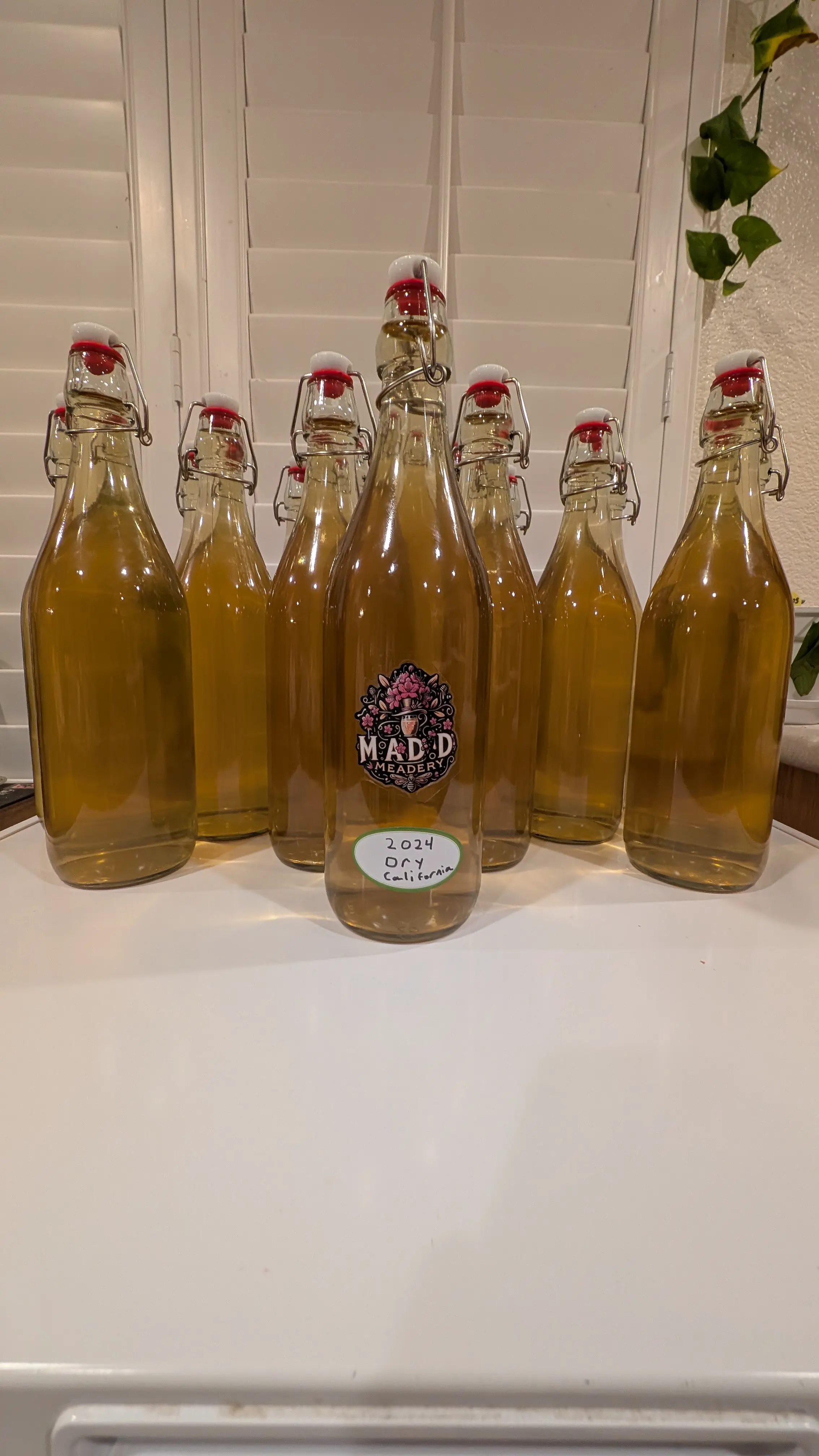After months of patient waiting, the moment finally arrived – my 8-gallon batch of mead was ready for bottling. What started as an ambitious brewing project in late 2024 has now transformed into liquid gold, and I'm here to share the tasting notes and bottling experience.

The Transformation
Looking back at that initial 1.04 specific gravity reading (which would theoretically produce around 5% ABV), I wasn't entirely sure what to expect. The fermentation process had been working its magic quietly in storage, and opening that vat for the first time in months was like unwrapping a present.
Bottling Day
The transfer from the 30-liter vat to individual bottles was both exciting and nerve-wracking. After all those months of fermentation, this was the moment of truth. The mead had clarified beautifully, leaving behind the cloudy appearance it had during the initial brewing phase.
First Impressions: The Aroma
The first thing that hits you is the aromatic honey smell – it's incredibly inviting and immediately transports you back to the apiary. Despite the dry fermentation process, the honey character remains prominent on the nose, promising something special in the glass.
The Tasting Experience
Initial Sip
That first taste is deceptive in the best way possible. The mead presents itself as surprisingly approachable – not immediately screaming "alcohol" at you. There's an initial impression that might make you think it's somewhat watery, almost understated in its presence.
The Reveal
But then – moments later – the true character reveals itself. The alcoholic kick arrives with a smooth, warming sensation that reminds you this is indeed a serious beverage. The dry character becomes apparent, delivering exactly what was intended during the brewing process.
The Finish
The mead concludes with a slight bitter kick at the end – likely from the complete fermentation of sugars and the yeast character. Despite this bitter note, the overall experience remains remarkably smooth, creating a complex drinking experience that evolves from sip to finish.
Reflections on the Process
Starting with a 1.04 specific gravity reading had me worried about ending up with a low-alcohol beverage, but the fermentation clearly worked more efficiently than expected. The dry character suggests the yeast (Premier Cote des Blancs) did its job thoroughly, converting available sugars into alcohol while leaving behind that characteristic dry mead profile.
The combination of the two honey types – the initial honey and the Kirkland Signature RAW Unfiltered SoCal Honey – seems to have created a complex flavor foundation that carries through even after fermentation.
Looking Forward: The San Antonio Apiary Connection
This 8-gallon batch should provide plenty of mead to enjoy throughout 2025 and beyond. Each bottle represents months of patience and the magic of fermentation transforming simple ingredients into something greater than the sum of its parts.
But the most exciting development is what's happening for future batches. This year, I've set up the San Antonio apiary to be able to run my own honey in my own meads. There's something incredibly satisfying about the prospect of a completely farm-to-glass operation – from tending the bees to harvesting honey to fermenting the final product. The terroir of San Antonio honey should add a unique local character to future batches that you simply can't get from store-bought honey.
Lessons Learned for Next Time
While this dry mead turned out excellently, I've learned that I definitely prefer sweet or at least semi-sweet meads over the bone-dry character. The bitter finish, while interesting, confirms that my palate gravitates toward more residual sweetness. Future batches will be planned with either back-sweetening techniques or controlled fermentation to retain more honey character.
I'm also planning to use primarily mead-focused yeast in the future rather than the wine yeast (Premier Cote des Blancs) used in this batch. Specialized mead yeasts are designed to better preserve honey characteristics and can be more predictable when aiming for specific sweetness levels.
The journey from mixing honey and water in a large vat to sipping finished mead has been incredibly rewarding. For anyone considering their own mead-making adventure, this experience reinforces that even when the initial gravity readings don't hit your exact targets, the fermentation process can still deliver excellent results.
Next time, I'm definitely investing in more honey upfront to hit that target 1.1 specific gravity, using my own San Antonio honey, mead-specific yeast, and techniques to achieve a sweeter final product – but for now, I'm more than satisfied with this smooth, dry, aromatic mead that's taught me so much about my preferences.
